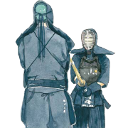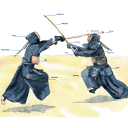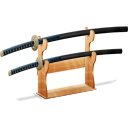HEIAN Era – 794-1184 AD
The first domestically forged swords with the original Japanese design of slightly arched blades and raised ridges were called Shinogi. The first documented use of the curved Japanese swords used in battle was by a samurai clan, known to attack whil on horse back in the south of Japan.
KAMAKURA Era – 1200-1299 AD
The samurai sword continued to rapidly improve in sword making production. Battle tested sword techniques improve dramatically.
MUROMACHI Era – 1392-1573 AD
100 year period of civil war and anarchy accelerates the number of Kenjutsu (sword techniques) schools (ryu) opening across Japan and refining the dissemination of advanced sword-handling and sword smithing techniques.
A new sword casting method called “Tatarafuki” using high grade iron sand from riverbeds was developed.
Lightly armored samurai became favored over being heavily armored in battle.
EDO Era – 1603-1867 AD
Relative peace in Japan.
Major writings about the kendo were published:
“The Book of Five Rings” by Miyamoto Musashi
“The Unfettered Mind” by the Priest Takuan
“Sword and Zen” written for the Shogun Tokugawa Iemitsu
“The Life-giving Sword” by Yagyu Munenori
The goal of kendo changed from of “destroying the enemy” to a goal of character development, moral and social justice.
First early types of kendo bogu emerges improving the level of competition, training and reducing injuries.
MEIJI Era – 1868-1911 AD
Samurai Class dissolved sending a whole class of society searching for a means to make a living as farmers, merchants, civil servants or what ever they could find.
TAISHO Era – 1912-1926 AD
Compilation of the best sword techniques used to create the Nippon Kendo Kata.
The term Kendo “way of the sword” officially adapted to be used instead of Kenjustu (sword techniques) The shinai (bamboo sword) accepted as the alternative to the Japanese sword.
MODERN
After the Second World War, Kendo was suspended for a while under the Occupation of the Allied Forces. In 1952, however, when the All Japan Kendo Federation was established, Kendo was revived. Kendo presently plays an important role in school education and is also popular among the young and old, men and women alike. Several million Kendo practitioners of all ages enjoy participating in regular sessions of Keiko (Kendo training).
Furthermore, Kendo is gaining interest all around the world, and more and more international practitioners are joining the Kendo world. The International Kendo Federation (FIK) was established in 1970 and the first triennial World Kendo Championships (WKC) was held in the Nippon Budokan in the same year. In May 2012, the 15th WKC was held in Novara, Italy. Kendo practitioners from 48 different countries and regions participated.










